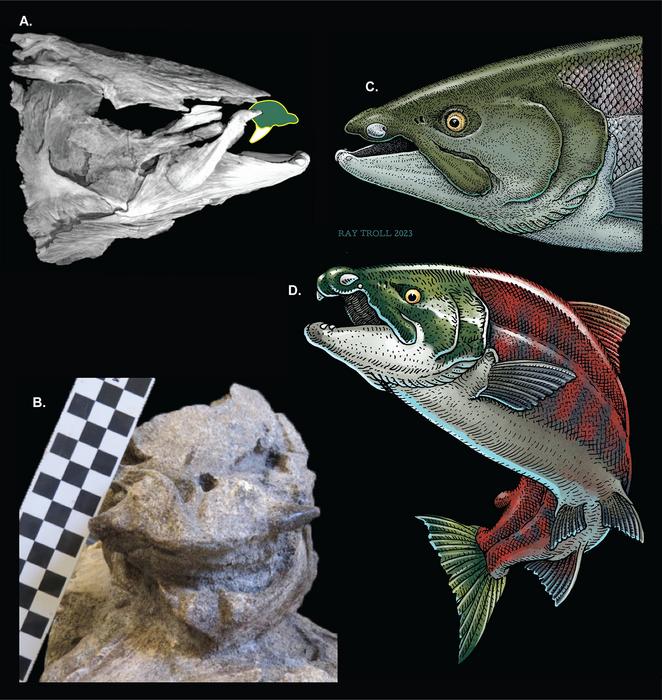Ancient Salmon Resembles Aquatic Warthog, Not Saber-Toothed Fish
Posted on Categories Discover Magazine

A giant, tusked salmon was once thought to resemble a fish version of a saber-toothed tiger. But turns out, it looked more closely to an aquatic warthog.
A newly reported fossil find is now prompting paleontologists to rethink the nickname of the largest known salmon species — Oncorhynchus rastrosus, according to an article in PLOS ONE. The fish, which grew to nearly nine feet long, lived 3 million to 5 million years ago in the Pacific Northwest.
A Saber-Toothed Salmon?
When paleontologists first reported fossils of O. rastrosus in 1972, they thought its oversized front teeth pointed backward into the mouth like fangs. This led to the nickname “saber-toothed salmon.”
However, the fossils that prompted that moniker were essentially lying flat and were scattered. The new specimens were found more intact.
“This locality had great specimens in three dimensions,” says Kerin Claeson, an anatomy professor at the Philadelphia College of Osteopathic Medicine and an author of the paper.
The team was initially puzzled by the fossils, because they were surprised to see the fossils’ teeth pointed in an unexpected direction. “That became one of those moments where you’re like, ‘Well, what’s going on here?’” says Claeson.
After the researchers analyzed those fossils, performed CT scans on them, and compared them to the earlier specimens, they determined that the salmon’s teeth jutted out sideways, more like tusks than fangs.
The find was especially fortuitous because the paleontologists weren’t fishing for this particular species. They were conducting a broad fossil hunt in an extinct river that is part of the Columbia River Basin.
Read More: The Minds of Ancient Fish May Explain the Evolution of Tetrapods
What Were the Tusks for?
As for function, the paleontologists think the salmon used the tusks for defense.
“I’d describe them as not-so-gentle giants,” says Claeson.
The massive salmon may have used the tusks to ward off predators in the open ocean or defend their nests in the river. According to Claeson, they would probably bash their head side to side and may have also used the tusks as shovels, to dig nests in the riverbed. Both males and females sported tusks.
The salmon probably didn’t use the tusks for eating, though, because O. rastrosus was a filter feeder — meaning they would strain plankton via a mesh-like structure. Therefore, they wouldn’t need teeth for chewing.
The next step is to consider why salmon eventually lost those formidable teeth.
“This seems to have been an experiment that lasted for a while, but ultimately was not necessary to keep Pacific salmon as a larger group intact and alive,” says Claeson.
Read More: Why Were Prehistoric Marine Reptiles So Huge?
Article Sources
Our writers at Discovermagazine.com use peer-reviewed studies and high-quality sources for our articles, and our editors review for scientific accuracy and editorial standards. Review the sources used below for this article:
Before joining Discover Magazine, Paul Smaglik spent over 20 years as a science journalist, specializing in U.S. life science policy and global scientific career issues. He began his career in newspapers, but switched to scientific magazines. His work has appeared in publications including Science News, Science, Nature, and Scientific American.